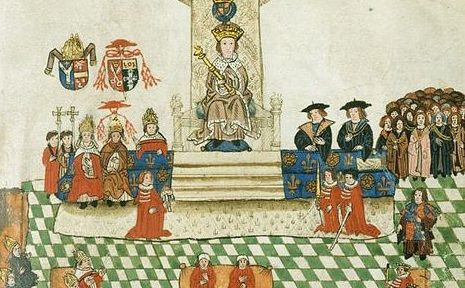
The First Act of Succession (at the time referred to only as the “Act of Succession”) was a key step in Henry’s repudiation of Catherine of Aragon: it recognized Elizabeth, his daughter with Anne Boleyn, as the true heir to the throne (until of course a son was born to this marriage!), and made Mary, his daughter with Catherine, a bastard. While the Church of England had already declared the same thing, this Act of Parliament bound the people much more directly.
It was a formidable weapon because it required every Englishman to swear an oath to recognize this Act, as well as the King’s supremacy:
And that all manner your subjects, as well spiritual as temporal … shall swear a like corporal oath, that they and every of them, without fraud or guile, to their cunning, wit, and uttermost of their powers, shall truly, firmly, and constantly observe, fulfil, maintain, defend, and keep the effects and contents contained and specified in this Act, or in any part thereof.
Those who refused – like Sir Thomas More and Bishop John Fisher – would be guilty of treason and executed. Henry wasn’t messing around!
[E]very such person and persons, of what estate, degree, or condition they be of … and their aiders, counsellors, maintainers, and abettors, and every of them, for every such offence shall be adjudged high traitors, and every such offence shall be adjudged high treason, and the offenders and their aiders, counsellors, maintainers, and abettors, and every of them… shall suffer pains of death, as in cases of high treason; and that also every such offender, being convicted as is aforesaid, shall lose and forfeit … all such manors, lands, tenements, rents, annuities, and hereditaments, which they had in possession as owners, or were sole seized of by or in any right, title, or means, or any other person or persons had to their use, of any estate of inheritance, at the day of such treasons and offences by them committed and done …
Interestingly, only two years later, the Act was superseded by the Second Act of Succession, passed in June 1536 and which vested the succession in Henry’s children by new wife Jane Seymour and made Elizabeth as illegitimate as Mary. Of course, since Henry did not as yet have any children by Jane Seymour, the Second Act also gave Henry “full and plenary power and authority” to choose a different successor in letters patent or through his final Will. Nor was this Henry’s final say on the matter: the Third Act of Succession, passed in July 1543, restored Mary and Elizabeth to the succession (though without removing their illegitimacy) behind Edward, Edward’s children, and any children Henry might yet have with then-wife Katherine Parr) – and of course subject to Henry’s continuing right to change his mind in letters patent or his Will…
SOURCES:
Wikipedia for the First Act of Succession, the Second Act of Succession, and the Third Act of Succession
Luminarium for the full text of the First Act of Succession
* * *
If you like my posts, you’ll love my books! My Seymour Saga trilogy tells the gripping story of the short-lived dynasty that shaped the Tudor Era. Jane the Quene skews romantic, The Path to Somerset is pure Game of Thrones (without the dragons), and The Boy King is a noir coming-of-age. Get them now through Amazon, Barnes & Noble, Kobo, and Apple, or even your local independent bookstore!

(PS Already read them? Did you love them? Then please review them – even just a stars rating! It makes a huge difference in helping new readers find them and would mean the world to me!)


The problems began with the remainder of this Third Act. Henry was so determined that the Tudor line should not die out after his death that he also added the offspring of one of his two sisters, Mary. The older sister Margaret had married James IV of Scotland, but despite this there was still bad blood between the two nations. To avoid any possible claim from Scotland Henry nominated further heirs through descent from the younger sister, Mary, who had been Duchess of Suffolk after her marriage to Henry Brandon. Their daughter Frances had married Henry Grey, Marquess of Dorset, and they had three daughters, of whom the oldest was the ill-fated Jane. For some reason he leap-frogged the mother and put Jane Grey into the succession
By the time the young Edward VI realised that he was dying at the tender age of 15, he was determined that the Reformist changes to religious observances that he had spent so long promoting should not be reversed by his pious Catholic half sister Mary, and he wiped the slate by nominating Jane as his heir in his will. The rest is well known.